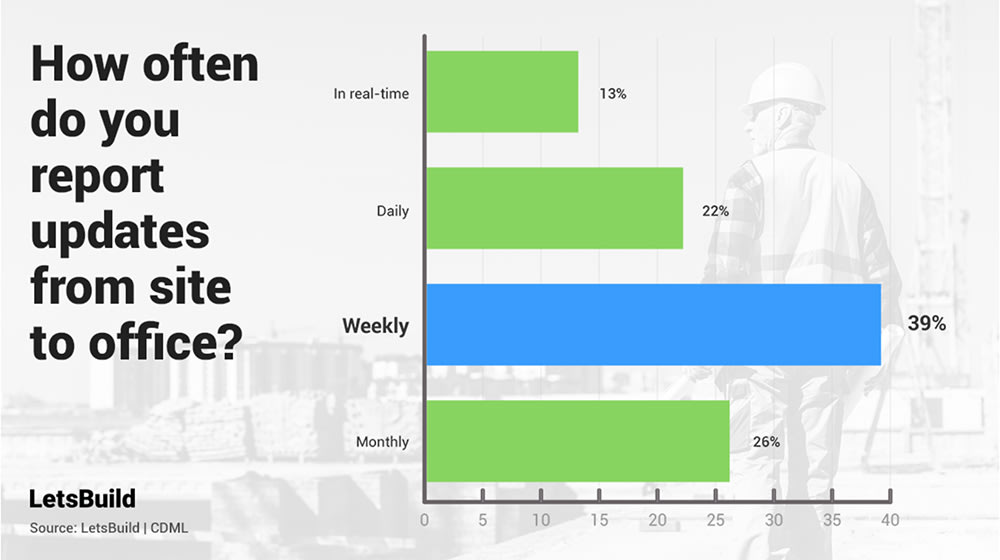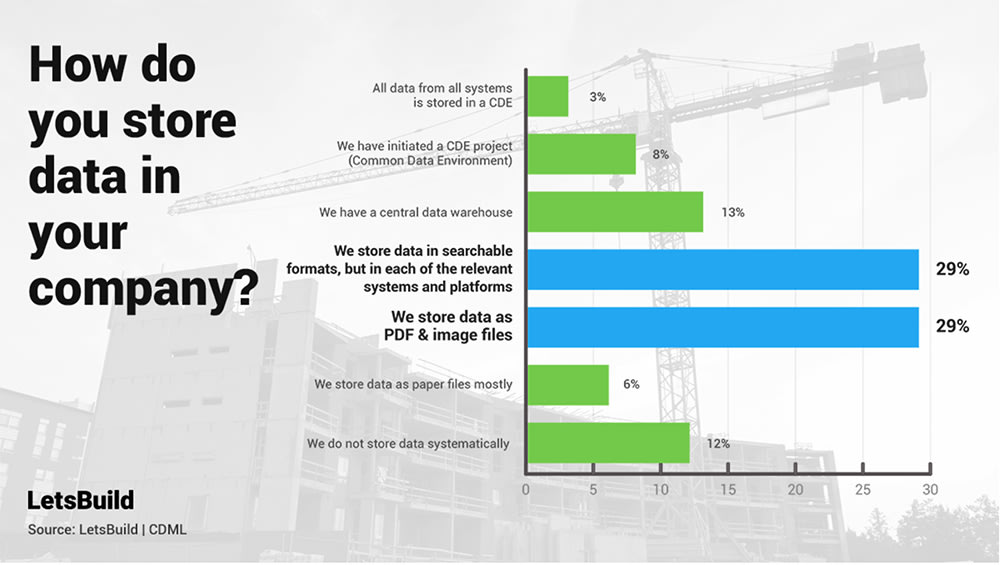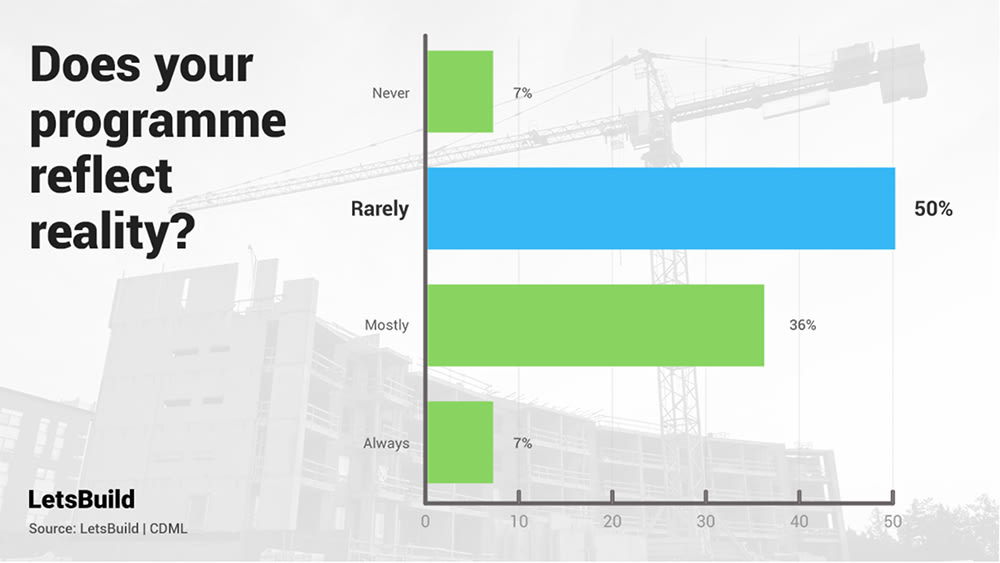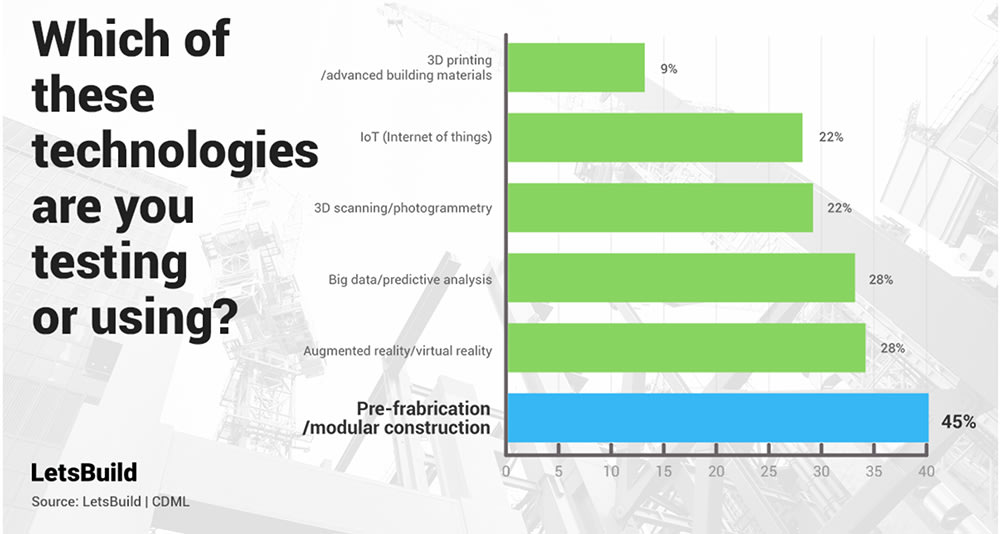Anastasios Koutsogiannis outlines the findings from LetsBuild’s Construction Digital Maturity Ladder.
Only 65% of people working in construction get updates from the site on a weekly or monthly basis. That’s simply not good enough for an industry that battles against low productivity and frustrating rework rates.
If we dream of real time, and catching problems as they arise, “reporting from site” must happen at least daily.
And this can be possible only if construction is ready to change its habits, become more efficient, and introduce a universal language and understanding across the entire industry through a common digital model.
So at the end of the day, everything comes down to the following question: How digitally mature is your business?

In an attempt to respond to this question, LetsBuild launched the Construction Digital Maturity Ladder (CDML), an eight-minute free online assessment that enables construction companies around the world to measure their digital maturity and compare their results to the rest of the industry.
“LetsBuild’s free and open source model was launched with the purpose of creating a common language on how to talk about and work with digital maturity in construction,” explains Ulrik Branner, executive and board member at LetsBuild.
In that way, there can be more clarity over the digital landscape and its interdependencies and accelerate the digital transformation of construction.
The CDML has already started to provide some very interesting stats and insights for construction, such as the figure that began this article. Here, we dig a little deeper into the data and shed more light on some of the most common industry practices.
Just 3% of the industry store their data in a Common Data Environment (CDE)
The way an industry stores its data tells a lot about its digital maturity and, by extension, its future. Construction is generating more data than almost any other industry in the world, but it seems to struggle when it comes to collecting and preserving these valuable beats of information.
According to the CDML findings, just 3% of the stakeholders in construction store their data in a CDE, while 12% have not even started to store it systematically yet.
The majority of the industry (58%) appears to prefer storing data either as PDF and image files or in searchable formats, but in each of the relevant systems and platforms. These numbers prove that construction is still working in an isolated way.

Such an approach makes it difficult for the entire industry to learn from its mistakes and share insights and project intelligence.
“Collaboration, communication and a much more open approach to sharing of best practice is fundamental for our €10tn per year industry to take the leap ahead that it deserves,” adds Branner.
Nevertheless, a promising sign for a digital paradigm shift in construction is appearing on the horizon. More analytically, 49% of the participants in the CDML assessment pointed at BIM as the top technology for their company within the next three years, while 30% mentioned that working towards a CDE is their focal point for the near future.
Does your programme reflect reality?
Programme in construction is king but it appears that the vast majority of the industry is still struggling with keeping its programme updated at any time. 50% of the CDML respondents revealed that their construction programmes rarely reflect reality. On top of that, another 7% admitted that their programme does not reflect reality at any point.
This lack of clear communication between the different project agents can lead to a number of misunderstandings, as people might come and go on site in vain waiting for their turn to complete the tasks that have been assigned to them.

It’s worth mentioning that these numbers go hand in hand with the issue of digital adoption on site. Construction companies need to push for a working field where every worker can easily report progress through their mobile device.
At the moment, as shown by the CDML, only 31% of the companies in construction provide company-paid smartphones to all of their employees. Trying to gradually increase this percentage could result in a more data-driven construction process.
Prefabrication and modular construction under the spotlight
Given the need for more control over planning in construction and the serious housing crisis that many markets are battling against, the rise of prefabrication and modular construction comes as no surprise.
“The problem we have at the moment is we are not going to build 300,000 homes a year, which is what the government is saying, building traditional. You have to have means of construction which are modern, technology-enabled and actually you are going to drive higher quality as well. Because you have a big problem in the market at the moment around poor quality homes,” explained Mark Farmer in a recent BBC interview.
This shift toward prefabrication and modular construction is also verified by the CDML findings. As you can see on the following chart, 45% of the participants are currently either testing or using prefabrication.

AR and VR as well as big data follow with 28% each showing that the industry is starting to realise that the road to a more efficient and less mistake-prone construction process goes through data and digital adoption.
“It is of the utmost importance that we as an industry become data-driven, because data is the foundation of information and learning,” highlights Branner.
However, this mindset change should also be reflected on the IT investment of the sector. As suggested again by the CDML data, less than 15% of the respondents invest more than 3% of their revenue in technology. This figure is expected to increase within the next few years but there is still a long way to go before we can claim that the construction industry pays enough attention to R&D.
Digital solutions could result in a 45% reduction of cost in construction
In a recent analysis conducted by McKinsey & Company, it was found that the proper implementation and use of digital tools in the industry could result in cost savings of up to 45%.
That said, making construction more profitable is eventually a matter of developing the digital strategy of the entire sector and investing in a fact-based way of working. This is where initiatives such as the Construction Digital Maturity Ladder (CDML) could be helpful.
“So I invite you, if you’re from the sector, to basically take the CDML assessment. It’s eight minutes, it’s a few questions. But based on those questions, you will have a good insight where you are, and what you need to do,” says Thomas Goubau, LetsBuild CRO.
The more insight is collected the easier it can be for stakeholders in construction to understand where they stand and turn digital gaps into functional demands allowing them to introduce and develop a healthy digital culture.
Anastasios Koutsogiannis is content marketing manager at LetsBuild, the end-to-end digital platform for construction











